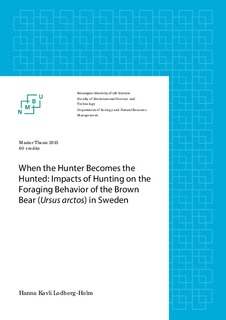| dc.contributor.author | Lodberg-Holm, Hanna Kavli | |
| dc.date.accessioned | 2016-03-31T12:47:47Z | |
| dc.date.available | 2016-03-31T12:47:47Z | |
| dc.date.issued | 2016-03-31 | |
| dc.identifier.uri | http://hdl.handle.net/11250/2383438 | |
| dc.description.abstract | Predation is a vital process in nature that has the potential to reduce prey populations, while also causing a wide range of risk effects such as changed prey behavior as a response to predation. Research has shown that animals may change their spatiotemporal use of a landscape as a response to human hunting, and such behavioral changes can occur also in apex predators. The brown bear (Ursus arctos) has previously been driven to near extinction in Scandinavia due to human persecution, and is still strongly limited by hunting. In Sweden, the hunting season overlaps with the bears’ hyperphagia stage, when bears depend on a near constant intake of berries prior to hibernation. In this thesis, I have explored the spatiotemporal foraging patterns of brown bears in south-central Sweden, using resource selection functions to show how bears select for spatially predicted bilberry (Vaccinium myrtillus), and lingonberry (Vaccinium vitis-idaea) availability, as well as foraging in areas with high predicted risk of hunting mortality. All bears selected for areas of high availability of bilberry and avoided areas of high lingonberry availability. Bears that survived the hunting season generally avoided areas of high risk, while the bears that were killed foraged in high risk areas prior to the hunting season. Different foraging strategies in relation to risk did not affect the bears’ selection for berry availability. In the 10 days before the start of the hunting season, none of the bears selected against areas of high risk, but during the 10 first days of hunting all bears shifted their foraging away from areas of high risk. There were individual differences between bears in relation to selection for bilberry and risk, but few differences in relation to selection for lingonberry and risk. I found no consistent differences in foraging behavior between different sexes and age classes of bears. I conclude that bilberries are important food resources for bears during hyperphagia, and that bears adapt their foraging behavior to the risk of being killed by human hunters. Changed behavior in apex predators as a result of human hunting may have implications for the entire ecosystem, and require increased research attention in the future. | nb_NO |
| dc.language.iso | eng | nb_NO |
| dc.publisher | Norwegian University of Life Sciences, Ås | |
| dc.rights | Navngivelse-Ikkekommersiell-IngenBearbeidelse 3.0 Norge | * |
| dc.rights.uri | http://creativecommons.org/licenses/by-nc-nd/3.0/no/ | * |
| dc.subject | Risk effects | nb_NO |
| dc.subject | Brown bear | nb_NO |
| dc.subject | Ursus arctos | nb_NO |
| dc.subject | Human hunting | nb_NO |
| dc.subject | Berries | nb_NO |
| dc.title | When the hunted becomes the hunted : impacts of hunting on the foraging behavior of the brown bear (Ursus arctos) in Sweden | nb_NO |
| dc.type | Master thesis | nb_NO |
| dc.subject.nsi | VDP::Mathematics and natural science: 400::Zoology and botany: 480::Ecology: 488 | nb_NO |
| dc.source.pagenumber | 56 | nb_NO |
| dc.relation.project | Scandinavian Brown Bear Research Project | nb_NO |
| dc.description.localcode | M-ECOL | nb_NO |

